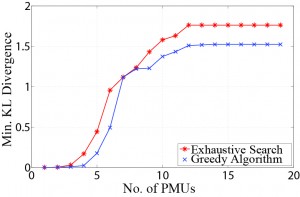Optimal PMU Placement for Quickest Line Outage Detection and Identification
Optimal PMU Placement for Quickest Line Outage Detection and Identification
PhD student Xichen Jiang with adviser A. Domínguez-García
Timely line-outage detection for power system transmission line outages is crucial for maintaining reliability in the power grid. Currently, many of the methods for online power system monitoring rely on a system model that is obtained offline, which can be inaccurate due to bad historical or telemetry data; such inaccuracies have been a contributing factor in many recent major blackouts. This lack of situational awareness limits the operators’ ability to identify and prevent critical contingencies, which can lead to instability and cascading failures. We propose an online measurement-based technique to detect and identify system topological changes. For this method, the statistical properties of electricity generation and demand are assumed to be known in addition to the power system model. To detect line outages, a statistical quickest change algorithm is applied to the voltage phase-angle measurements collected from phasor measurement units (PMUs). When a line outage occurs, the statistical properties of the measured voltage phase angles change. This is detected by the algorithm.
Additionally, a method to optimally place PMUs for a partitioned power system is proposed. The optimal PMU placement scheme is formulated as an integer program. Figure 1 compares the performance of a greedy PMU placement scheme to the optimal PMU placement scheme for a partitioned IEEE 30-bus system. From Figure 1, it is evident that the greedy scheme performs nearly as well as the optimal placement scheme. Figure 2 shows that for a line outage of line (60, 62) of the IEEE 118-bus system, the line-outage detection algorithm successfully detects the line outage after 38 samples for a threshold of 100. This research is funded by NSF ECCS 09 54420 CAR.

